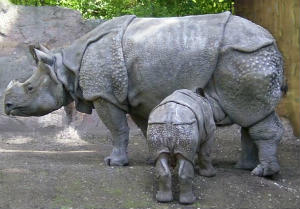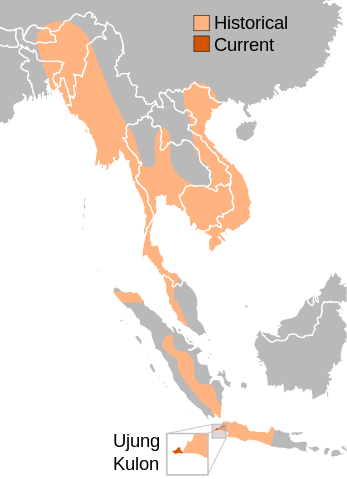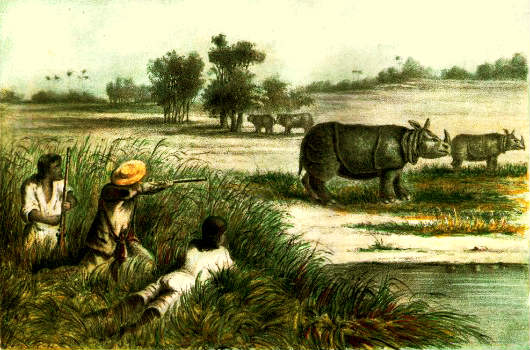Javan Rhino Babies
3 rare calves born in Javan park
|
|

Javan rhinoceros mother and calf (Image: Wikimedia)

Range of the Javan Rhinoceros (Rhinoceros sondaicus), past and present
9/10/2015 — Sure, Prince George and Princess Charlotte are great. And so were the natural hatchlings of Galapagos tortoises reported last week. But now it’s time to celebrate the birth of other babies. Three Javan rhinoceros calves born in an Indonesian national park.
The darling babies were captured on film in Ujung Kulon National Park, sometime between April and July (see video above). The tubby ones were each born to different mothers, and each looked healthy. No word on how the moms are doing, but we have to assume they, too, are fine.
The three are two more than the number of Javan rhino babies spotted in 2014. The total number of surviving animals worldwide is now 60. All reside in Ujung Kulon, which lies on the extreme western tip of Java (see map right).
"This is wonderful news," Widodo Ramono, head of conservation group the Indonesian Rhino Foundation, told AFP news agency. "Now we just need to ensure their protection."
At one time the Javan Rhinoceros (Rhinoceros sondaicus), also known as the Sunda Rhinoceros, was the most common rhinoceros in Asia. It lived on the islands of Java and Sumatra, throughout Southeast Asia, and was even found in India and China. But now it's critically endangered, perhaps the rarest large mammal on earth, with the Ujung Kulon herd being the single known population in the wild. A second population in Vietnam is now thought to be extinct. There are no Javan rhinoceroses in captivity, and the birthrate of wild Javan rhino babies is down to only a couple of calves a year.

Dutch hunter with dead Javan rhinoceros (Ujung Kulon, 1895)
Formerly hunting, and now poaching, have been the primary cause of the Javan rhino's sad decline. Loss of habitat, especially during the Vietnam War, has also led to their decimation. And the Chinese demand for their horns for medical purposes keeps the pressure on. In China, where it is widely believed that rhinoceros horn has healing properties, a single kilogram of horn can bring as much as $30,000 on the black market. The hides of these animals, too, were once used there in the manufacture of armor.
Please do what you can to protect these rare, beautiful and precious animals.
 With the influx of Europeans into Asia during the 19th century, the pressure on rhinos from hunting greatly increased. (Image: "Auch ein Anstand", from W. F. A. Zimmermann, Der Vulcanismus oder das Todesthal auf Java, 1861)
With the influx of Europeans into Asia during the 19th century, the pressure on rhinos from hunting greatly increased. (Image: "Auch ein Anstand", from W. F. A. Zimmermann, Der Vulcanismus oder das Todesthal auf Java, 1861)
Most shared on Macroevolution.net:
Human Origins: Are we hybrids?
On the Origins of New Forms of Life
Mammalian Hybrids
Cat-rabbit Hybrids: Fact or fiction?
Famous Biologists
Dog-cow Hybrids
Georges Cuvier: A Biography
Prothero: A Rebuttal
Branches of Biology
Dog-fox Hybrids
